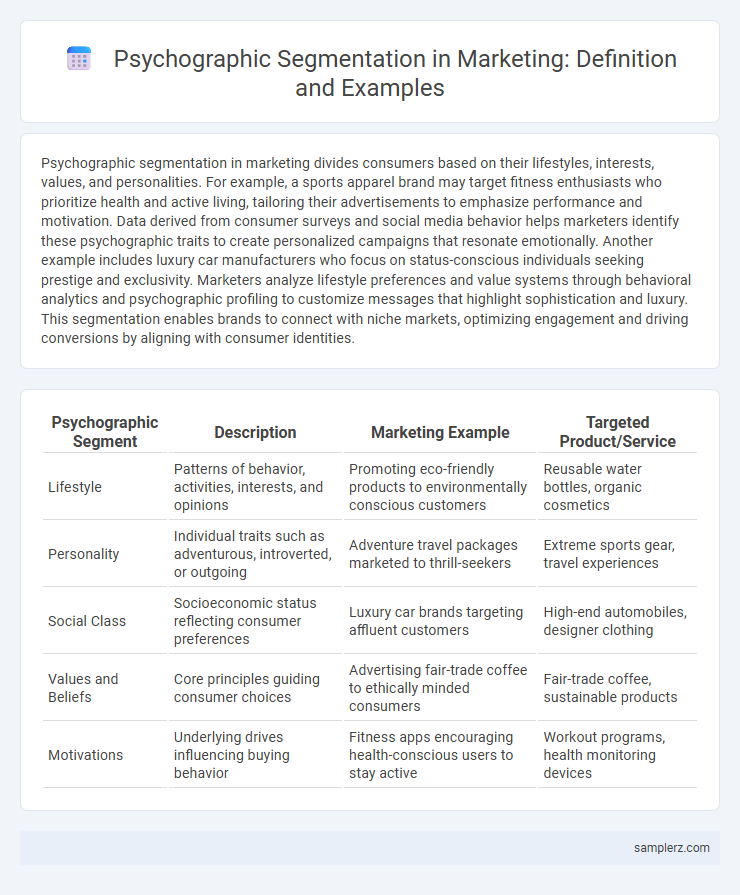Psychographic segmentation in marketing divides consumers based on their lifestyles, interests, values, and personalities. For example, a sports apparel brand may target fitness enthusiasts who prioritize health and active living, tailoring their advertisements to emphasize performance and motivation. Data derived from consumer surveys and social media behavior helps marketers identify these psychographic traits to create personalized campaigns that resonate emotionally. Another example includes luxury car manufacturers who focus on status-conscious individuals seeking prestige and exclusivity. Marketers analyze lifestyle preferences and value systems through behavioral analytics and psychographic profiling to customize messages that highlight sophistication and luxury. This segmentation enables brands to connect with niche markets, optimizing engagement and driving conversions by aligning with consumer identities.
Table of Comparison
| Psychographic Segment | Description | Marketing Example | Targeted Product/Service |
|---|---|---|---|
| Lifestyle | Patterns of behavior, activities, interests, and opinions | Promoting eco-friendly products to environmentally conscious customers | Reusable water bottles, organic cosmetics |
| Personality | Individual traits such as adventurous, introverted, or outgoing | Adventure travel packages marketed to thrill-seekers | Extreme sports gear, travel experiences |
| Social Class | Socioeconomic status reflecting consumer preferences | Luxury car brands targeting affluent customers | High-end automobiles, designer clothing |
| Values and Beliefs | Core principles guiding consumer choices | Advertising fair-trade coffee to ethically minded consumers | Fair-trade coffee, sustainable products |
| Motivations | Underlying drives influencing buying behavior | Fitness apps encouraging health-conscious users to stay active | Workout programs, health monitoring devices |
Understanding Psychographic Segmentation in Marketing
Psychographic segmentation in marketing involves dividing consumers based on lifestyle, values, personality traits, and interests, enabling businesses to create targeted campaigns that resonate on a deeper emotional level. For example, a fitness brand might segment its market into health-conscious individuals who prioritize wellness and active lifestyles, tailoring messaging that highlights product benefits for energy and vitality. This approach enhances customer engagement by aligning marketing strategies with consumers' intrinsic motivations and preferences.
Key Psychographic Variables Used in Marketing
Key psychographic variables used in marketing include lifestyle, personality traits, values, attitudes, and interests, which help businesses create targeted campaigns that resonate with specific consumer groups. Segmenting audiences based on these variables allows marketers to tailor messaging that aligns with customers' motivations and behavior patterns, enhancing engagement and conversion rates. Brands often use these insights to develop personalized content, product recommendations, and emotional appeals that deepen customer loyalty and drive sales.
Lifestyle-Based Segmentation: Real-World Examples
Lifestyle-based segmentation targets consumers by their daily activities, interests, and opinions, enabling brands to tailor marketing strategies effectively. For instance, Nike segments customers into fitness enthusiasts, casual exercisers, and professional athletes to create personalized campaigns promoting specific products like running shoes or training gear. Another example is Whole Foods Market, which appeals to health-conscious, organic lifestyle seekers by highlighting natural and sustainable product offerings.
Segmenting Audiences by Interests and Hobbies
Segmenting audiences by interests and hobbies enables marketers to tailor campaigns that resonate with specific passion points, such as fitness enthusiasts or gaming communities. By analyzing consumer behavior patterns and engagement metrics, brands can deliver personalized content that increases relevance and conversion rates. This psychographic approach enhances customer loyalty and drives higher ROI through targeted messaging aligned with audience lifestyles.
Behavioral Attitudes and Consumer Choices
Psychographic segmentation in marketing often targets consumers based on their behavioral attitudes and choices, such as brand loyalty, product usage frequency, and lifestyle preferences. For example, marketers may segment health-conscious consumers who prioritize organic products and prefer sustainable brands, influencing targeted campaigns and product development. Understanding these behavioral patterns allows businesses to tailor messaging and offers that resonate deeply with specific consumer mindsets.
Values and Beliefs: Shaping Brand Communication
Psychographic segmentation in marketing leverages values and beliefs to tailor brand communication, enhancing emotional connections with target audiences. Brands that align messaging with customers' core principles--such as sustainability, social justice, or innovation--drive stronger loyalty and engagement. For example, Patagonia emphasizes environmental responsibility in campaigns, resonating deeply with environmentally conscious consumers.
Personality Traits Influencing Purchasing Decisions
Psychographic segmentation in marketing targets consumers based on personality traits such as openness, conscientiousness, extraversion, agreeableness, and neuroticism, which significantly influence purchasing decisions. Brands often tailor messages to match traits like introversion or risk-taking behavior to enhance customer engagement and loyalty. Understanding these personality-driven preferences enables marketers to create personalized campaigns that resonate deeply, driving higher conversion rates and brand affinity.
Social Status and its Impact on Market Segments
Social status is a crucial psychographic segmentation variable that helps marketers target consumers based on their perceived social hierarchy and lifestyle preferences. High-status individuals often prefer luxury brands and premium products that symbolize success and exclusivity, while middle and lower social segments may prioritize value and functionality. Understanding social status enables companies to tailor their messaging and product offerings to resonate with distinct market segments, driving more effective marketing campaigns and customer loyalty.
Case Studies: Brands Succeeding with Psychographic Segmentation
Nike's "Just Do It" campaign leverages psychographic segmentation by targeting athletes and fitness enthusiasts who value motivation and perseverance, resulting in increased brand loyalty and sales. Patagonia focuses on environmentally conscious consumers by promoting sustainability and ethical practices, resonating deeply with their target market. Starbucks appeals to social and experience-driven customers by creating a personalized and community-centered atmosphere, driving customer engagement and repeat visits.
Best Practices for Implementing Psychographic Insights in Campaigns
Effective implementation of psychographic segmentation in marketing campaigns involves leveraging detailed customer lifestyle, interests, and values data to create highly personalized messaging. Brands like Nike utilize psychographic insights by targeting fitness enthusiasts with motivational content that aligns with their active lifestyles, enhancing engagement and conversion rates. Incorporating psychographic profiles into marketing automation tools allows for dynamic content delivery tailored to consumer attitudes and motivations, driving more meaningful interactions and brand loyalty.

example of psychographic segmentation in marketing Infographic
 samplerz.com
samplerz.com